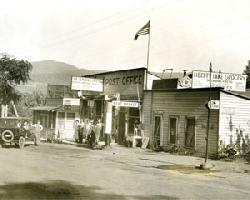|
||||
|
Utilities serving LL improved with time, technology
6/26/2013 3:38:19 PM
By Ross Schneidmiller
Liberty Lake Historical Society
Today at Liberty Lake, we might take our utilities for granted. Yes, we are proud of our award-winning sewer and water district and its efforts to keep the lake clean. Download and upload speeds as well as what cable channels we get might be part of conversations by the water cooler. But, we expect the convenience of the available utilities and generally only speak of them when something goes wrong.
Our early settlers had none of these services. No inside plumbing, just a small wood structure covering a hole. Water service meant carrying water from the lake, creek or spring. Communication was eventually by snail mail. It got real techie when you could travel by horse to your local telegraph office and communicate with distant relatives. Of course, it would usually take days until they would return a telegram.
Alexander Graham Bell patented the telephone in 1876, the year of our nation's centennial. It would be a couple of decades later before Liberty Lake benefitted from it. Roderick MacKenzie, who owned significant property on the west side of the lake and operated the hotel which bore his name, was instrumental in bringing phone service to the community. He got area settlers to donate a day's labor to haul and install the poles connecting to a line north of the river. Few phones existed at first, and many would travel to the hotel to make calls.
As the system progressed, a telephone exchange was located in the general store on Melkapsi on the west side of the lake. The exchange consisted of a manual switchboard run by an operator. Using this type of service, the caller turned a crank to generate a ringing current to gain the operator's attention. The operator then connected the call to the verbally requested number by plugging the ringing cord into the jack on the switchboard corresponding to the called customer's line. Early on, there were not many phone customers, so the store clerk could be the operator and handle the store customers as well.
This phone system featured party lines, with multiple customers sharing a single line. When connecting to the called customer, the operator would use a distinctive ringing sequence, such as two short rings followed by a long, for each customer. Everyone on the party line could hear the rings and listen in on the calls, but hopefully only the intended party would pick up the phone.
The telephone lines consisted of two uncoated wires susceptible to getting crossed in windstorms, rendering the lines useless. In an oral history with this author back in 1987, Pete Higgins, a former lifeguard at Dreamwood Bay Resort in the early '30s, recalled needing to fix the lines. He could tell about where the lines crossed between the Dreamwood resort and the switchboard on Melkapsi by how hard the phone cranked. The closer to the resort, the harder the phone would crank. After he would uncross the wires, he would often travel around the community and see others repairing the lines that affected them.
The first water systems at the lake comprised the collection and distribution of spring water. High ground spring water would be collected in a holding tank, and gravity would provide the pressure. These systems were such a nice improvement that both Kalez Park and Dreamwood Bay Resort included the feature in their advertising. When west side lots on Wicomico Beach were marketed in 1908, The Spokesman-Review read:
West of the south end of the tract is a ravine in which are three large and ever-flowing springs. A concrete dam and reservoir are being installed to impound these waters and thus provide an ample supply of pure spring water under pressure, which is piped to every lot for domestic use and for spraying lawns, etc.
Prior to 1910, it was discovered that this supply was not adequate for all purposes, and a lake water system was introduced, the water being supplied by pumps. After this was installed, the spring water system was used for only drinking and cooking purposes.
Well water eventually became the primary source for domestic water at the lake. The two original water utilities were Liberty Lake Utilities and the Eastside Liberty Lake Water Improvement Club, the latter of which is still operating today. Liberty Lake Utilities also operated and expanded a sewer system, which was originally built by the Wicomico Beach developer.
Other than the west side of the lake, as the community grew, sewage was handled by residential septic systems. In 1973, the community voted to form the Liberty Lake Sewer and Water District with a majority of those non-sewered residences converted to sewer by the late '70s.
The building of the railway spur line into the lake in 1907 brought with it the bonus of electrical power. Prior to that, candles were used along with kerosene lanterns for light and mostly wood and kerosene stoves for heat. However, it took several years for power lines to access the far reaches of the lake. Electricity had not reached the Hotel Zephyr on the southeast corner of the lake until 1913, when its owners installed a lighting system powered by acetylene (a fuel used in welding and soldering), replacing the original system using kerosene.
Garbage was originally burned or hauled to the landfill by the individual. There was more than one dump in close proximity to the lake residents. Weekly garbage pick-up, which was done by Valley Garbage, did not begin until the mid-1900s.
The energy spent by the early settlers on day-to-day tasks was considerable. And when we take into account the efforts they made to improve their situation, much to our benefit, we probably appreciate our utilities a little more.
Ross Schneidmiller is president of the Liberty Lake Historical Society and a lifelong resident of the community.



